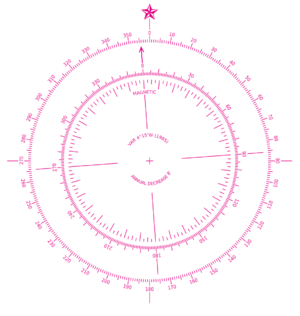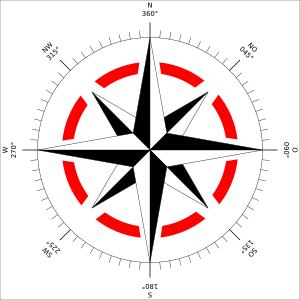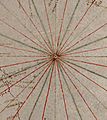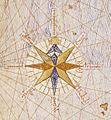Compass rose facts for kids
A compass rose is a special design you see on a compass, map, or nautical chart. It helps you find your way by showing the main directions: North, East, South, and West. It also shows the directions in between, like Northeast or Southwest.
You can find compass roses on almost all navigation tools today. This includes maps, GPS devices, and other equipment that helps people find their location.
The modern compass rose usually shows eight main directions. Here they are, going clockwise:
| Compass point | Abbr. | Heading | Traditional wind |
|---|---|---|---|
| North | N | 0° | Tramontane |
| North-East | NE | 45° | Greco or Grecale |
| East | E | 90° | Levante |
| South-East | SE | 135° | Sirocco |
| South | S | 180° | Ostro or Mezzogiorno |
| South-West | SW | 225° | Libeccio or Garbino |
| West | W | 270° | Ponente |
| North-West | NW | 315° | Maestro or Mistral |
Even though we use N, NE, E, and so on today, older compasses used traditional Italian names for these directions. These names came from the Middle Ages.

Contents
Different Kinds of Compass Roses
Compass roses can have different numbers of points:
- 4-point compass roses show only the four main directions: North, East, South, and West. These points are 90 degrees apart.
- 8-point compass roses show the four main directions plus the four in-between directions: Northeast, Southeast, Southwest, and Northwest. These points are 45 degrees apart.
- 16-point compass roses add even more points by dividing the angles in half again. These new points are called "half-winds." For example, between North and Northeast, you'll find North-northeast (NNE) and East-northeast (ENE). These points are 22.5 degrees apart.
- 32-point compass roses divide the angles even further. These points are called "quarter-winds" and are 11.25 degrees apart. Naming all 32 points on the rose is sometimes called "boxing the compass."
History of the Compass Rose
People have always needed to know directions. Most groups of people around the world have four main directions. Often, these names come from things nearby, like "towards the mountains" or "towards the sea." They can also come from the sun or winds. People who travel a lot often use where the sun rises and sets for East and West. They use the direction of different winds for North and South.
Modern Compass Roses
Today's compass roses often have two rings. The outer ring shows true directions. This means it points to the actual North Pole on Earth. The inner ring shows magnetic directions. This is where a magnetic compass needle points.
The difference between true north and magnetic north is called magnetic variation. This difference changes depending on where you are on Earth.
Where Compass Roses Are Used
The compass rose is a very common symbol. Here are some places you might see it:
- The NATO symbol uses a four-point compass rose.
- Outward Bound, an outdoor education group, uses the compass rose as its logo.
- An 8-point compass rose was the logo for Varig, a large airline in Brazil.
- The Seattle Mariners baseball team uses an 8-point compass rose in their logo.
- The Hong Kong Correctional Services uses a four-point star in its crest.
- The compass rose is a symbol for the worldwide Anglican Communion of churches.
- IBM used a 16-point compass rose as the logo for its System/360 computers.
- The Spanish National University of Distance Education (UNED) uses a 16-point compass rose as its official logo.
- The Central Intelligence Agency (CIA) in the United States has a 16-point compass rose on its seal and flag.
Images for kids
-
A 16-point compass rose on the grounds of a library serves both as a teaching tool and public art.
-
First ornate compass rose depicted on a chart, from the Catalan Atlas (1375), with the Pole Star as north mark.
See also
 In Spanish: Rosa de los vientos para niños
In Spanish: Rosa de los vientos para niños






